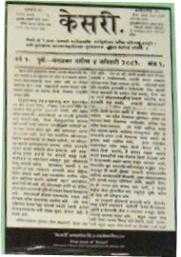Kesari (newspaper)
This article is about the Marathi newspaper. For other uses of the word, see Kesari (disambiguation)
 | |
| Type | Daily newspaper |
|---|---|
| Founded | 1881 |
| Language | Marathi |
| Official website | dailykesari.com |
Kesari (Marathi: केसरी) is a newspaper founded in 1881 by Lokmanya Bal Gangadhar Tilak, a prominent leader of the Indian Independence movement.[1]
Bal Gangadhar Tilak used to run his two newspapers, the Kesari, in Marathi and Maratha in English from Kesari Wada. The Wada still has the offices of Kesari, and mementos of Tilak, including his writing desk original letters and documents, and the first India national flag unfurled by Madame Cama. During Ganapati festival, the Wada is visited by a large number of people.
The Kesari and the Kolhapur Affair
This was a particular controversy regarding the ‘madness’ of Shivaji IV, the minor Raja of Kolhapur (Chhatrapati), a princely state in the southern part of Bombay Presidency, which took place in early 1880s. The British officials and doctors were of the opinion that Shivaji IV was suffering from an incurable ‘madness’. This official version received support from English newspapers such as the Times of India and the Bombay Gazette.
However, some Indian-owned newspapers such as Induprakash, Mahratta and Kesari disputed this. In the Kesari there was a public questioning of the diagnosis, treatment and mental state of the Chhatrapati. The Kesari, then under the editorship of Agarkar, and the Mahratta under Tilak, argued that Shivaji IV was not ‘mad’ and the little instability in his mental state was caused by the maltreatment given to him by the servants and officials appointed to take care of him.
They especially accused Madhav Barve, the British appointed Karbhari (Chief Administrator) of Kolhapur for complicity in a conspiracy to make Shivaji IV mad. They published in the Kesari and Mahratta letters allegedly written by Madhav Barve to his subordinate officials, which indicated his involvement along with some British officials and native servants in a plot to poison Shivaji IV.
To clear himself of the charges, Madhav Barve filed a defamation case against Tilak and Agarkar. The trial which followed brought into the public sphere the private life of Shivaji IV and the ill treatment meted out to him by British officials .
The Kesari published the verbatim account of the High Court trial drama, which in its editors' opinion exposed to public scrutiny the barbarous attitude of the British officers towards Shivaji IV. On 16 July 1882m the jury found Tilak and Agarkar guilty on the charge of slander against Madhav Barve and sentenced them to four months’ imprisonment at the Dongri jail in Bombay.
Even during the trial, Kesari published articles which questioned the physical control of British officers over the body of Shivaji IV and expressed fears regarding danger to Shivaji IV’s life from officers appointed to protect him. In spite of such accusations the British Government did not remove Shivaji IV from the custody of these officers. Eventually, Shivaji IV died on December 25, 1883 in a scuffle with a British soldier appointed to take care of him. The whole episode became famous as the Kolhapur Prakaran (affair).
See also
References
- ↑ Inamdar, Siddhesh (January 04, 2010). "Tendency to dumb down journalism disturbing: N. Ram". Pune: The Hindu. Retrieved January 07, 2013.
